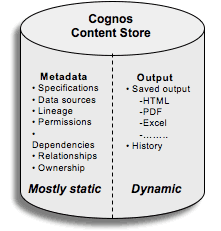by Rick Ryan - Envisn, Inc.
At a recent IBM Cognos Forum we delivered a session titled Demystifying Your Content Store to over 100 attendees. Right up front we asked some questions to find out how familiar the attendees were with their Cognos Content Store. Less than 1 in 5 had any working knowledge of the function of the Content Store, how it works or how much content they had in theirs. Not surprising really, since for most people it’s just something that is part of their Cognos environment.
The Cognos Content Store has two essential roles. Its first is to act as a repository for the Cognos 8 metadata. Its other major function is as a storehouse for users output. It contains such things as:

Basically, it has everything about every object in Cognos Connection.
The Content Store is designed and optimized for high speed reporting and it does this very well. But like a lot of things that have a single, primary focus, it does other things less well. Relatively simple things like providing administrators what they need to do their job effectively. Some examples are:
- How big is my Content Store?
- What’s the mix of the objects?
- How much saved output is there?
- How fast is it growing?
- Where is the growth occurring?
For many Cognos Administrators the recognition that these can be important questions is often not realized until they have a problem. While these and other questions can be answered with queries into the Content Store, this is a real pain to have to do on an ongoing basis. Plus, it doesn’t give you the ability to really manage or understand many of the things we find in the metadata like dependencies, relationships, etc. If we had this information in a useable way we could easily assess the impact of database changes on our reports and queries or which version of a model a report was using. There are also a myriad of other things that need to be addressed by Cognos administrators, and in some cases, by authors or developers as well.
To address these issues one has two choices. Try and build something yourself or look to see what may be available on the market to address these kinds of needs. The problem with the first approach is that few individuals have the time and resources to do it themselves. And even if you get something created, you face the challenge of managing required changes over time as new versions become available.
The second option may be the only practical way to address what administrators need provided they can get the financial resources to do this. Then they face the question of where and what to look for that will meet their current and future needs.
In our next blog we will cover some of the challenges of getting information from the Cognos Content Store and things you need to know before you start.
© Envisn, Inc., All rights reserved.





